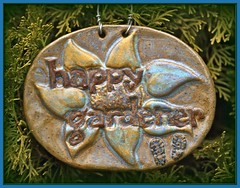 STEP ONE: WEDGING THE CLAY
STEP ONE: WEDGING THE CLAYTo ready the clay for the wheel, I work a few pounds at a time in a circular motion, like kneading bread dough. This eliminates air bubbles and evens out any inconsistencies.
STEP TWO: WEIGHING THE CLAY
To make mugs the same size, I weigh the clay. Fourteen ounces or one pound makes a good-sized mug. I pat it into balls and bring them over to the wheel.
 STEP THREE: CENTERING THE CLAY
STEP THREE: CENTERING THE CLAYI throw a ball of clay onto the center of the wheel and give the wheel a good kick to get it spinning. I wet the ball with some water and center the clay by pulling it up and then pushing it down into a mushroom-shaped ball.
STEP FOUR: PULLING UP THE WALLS
I make a hole in the middle with my thumb and open up the interior space of the mug. Then I can pull up the clay between my two hands to make the sides, or walls of the pot. I use a sponge to keep the clay wet at all times.
STEP FIVE: GETTING IT OFF THE WHEEL
After coaxing the clay into the desired shape, I need to carefully remove it from the wheel. I use a wire to loosen it from the plywood bat and then pry the bat carefully from the wheel. I set it aside and let it harden up for a few hours.
Once the pot is dry enough to be handled I can trim off the excess clay on the bottom. This creates a foot for the mug to rest nicely on and lightens the piece both visually and literally. I then impress my personalized stamp on the bottom edge.
STEP SEVEN: PULLING A HANDLE
I make my handles by pulling on a lump of clay. With generous amounts of water I continue to shape and lengthen it through repeated pulls. I cut the finished handle off the lump and set it down to harden a bit.
STEP EIGHT: ATTACHING A HANDLE
After allowing the handles to firm up, I attach them. I score the pot where I want to place the handle, add some slip (very wet clay) and press the handle onto the pot. I smooth out the seams and set it to dry.
STEP NINE: ADDING DECORATION
If I want to add decoration, I can do this in several ways. Because the mug is still wet enough to work, I can carve or impress designs directly onto the piece. Another way is by adding clay. I do this by sculpting on the mug itself or use one of my handmade stamps. With stamps, I roll out clay, cut out around the stamp, and press the clay into it. I then score, slip, and attach it onto the side of the mug.
STEP TEN: READY FOR FIRING
I give the pot another once over, making sure all is smooth and true. Then I set the mug down and wait for it to become bone dry. When all the moisture is out of the pot, I can start the next series of steps that involve firing, glazing and firing again.
Nothing about making mugs the way I do is efficient. It does not need to be. It is about slowing down and enjoying each step.
STEP EIGHT: ATTACHING A HANDLE
After allowing the handles to firm up, I attach them. I score the pot where I want to place the handle, add some slip (very wet clay) and press the handle onto the pot. I smooth out the seams and set it to dry.
If I want to add decoration, I can do this in several ways. Because the mug is still wet enough to work, I can carve or impress designs directly onto the piece. Another way is by adding clay. I do this by sculpting on the mug itself or use one of my handmade stamps. With stamps, I roll out clay, cut out around the stamp, and press the clay into it. I then score, slip, and attach it onto the side of the mug.
STEP TEN: READY FOR FIRING
I give the pot another once over, making sure all is smooth and true. Then I set the mug down and wait for it to become bone dry. When all the moisture is out of the pot, I can start the next series of steps that involve firing, glazing and firing again.
Nothing about making mugs the way I do is efficient. It does not need to be. It is about slowing down and enjoying each step.












































